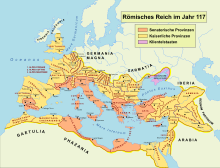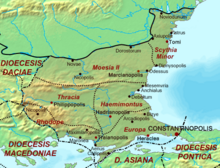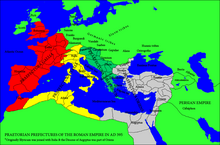Thrace (province)
Thrace or Thrace ( Latin provincia Thracia ; ancient Greek Θρᾴκη Thráke , formally ἐπαρχία Θρᾳκῶν eparchia Thracon ) was a province in the Roman Empire , which existed in different borders from 46 AD to 395.
Overview
The name of the province of Thrace was derived from the name of the Thrace region in which the Thracians lived. It was founded as an imperial province in AD 46 after the previous Thracian kingdom of the Odryses, which was dependent on Rome , had been occupied by Claudius (ruled 41-54).
The Romans encouraged handicrafts in the new province, mainly where urban settlements already existed, expanded the road network and built temples until the places developed into cities with a Roman influence. This created a bourgeois class that owned considerable estates. The officers, military officials and the soldiers themselves, who came from other parts of the Roman Empire or from Italy, the settled veterans and the officials, merchants and craftsmen brought into the country played a major role in the Romanization of Thrace and the emergence of urban life.
In the Roman Empire, the province of Thrace represented the border between the western and eastern halves of the empire; As the easternmost province on European territory, it was the outpost towards the east and also served as a deployment area for Rome's military actions. Thrace was also an important recruiting area for the Roman troops, as its inhabitants were commonly considered brave, tenacious, and numerous; for example, Spartacus came from Thrace. Roman legions ( I Italica , V Macedonica and XI Claudia ) and many auxiliary troops were stationed on the northern border ( Danube Limes ) of the former Thracian territories . During the entire Roman period, however, the province of Thrace was not a border province and was spared from enemy incursions.
These were the prerequisites for the province to flourish from the middle of the 2nd to the middle of the 3rd century. Generally speaking, the time of the Severians is considered to be the time of prosperity in Roman Thrace. As a result of the spread of Roman life, large parts of the province were Romanised, but Greek for the most part became the official language. However , there was no fixed language border (see Jireček line ).
After the imperial reform of Emperor Diocletian (284-305), the province of Thrace was divided into four smaller provinces, one of which was called Thrace (see below ). From the 4th century, after the division of the empire, Thrace belonged to the Byzantine Empire .
The Roman province of Thrace existed until the 7th century. It was then replaced by the Byzantine theme of Thrace , which existed from about 680 to 1204 and then again from 1230 to the 14th century. One issue was the basic administrative unit in the Byzantine Empire.
location
The province of Thrace was at an important geopolitical hub. Four of the major military roads, the Via Egnatia , the Via Diagonalis (Militaris), the Via Pontica and the Via Traiana crossed here, connecting Europe with Asia Minor and the Middle East. At the same time, the province had access to three seas, the Marmara Sea, the Aegean Sea and the Black Sea. However, Thrace was not a border province, it was not until late antiquity that a few smaller military units were stationed there.
Thrace under the principate until the Diocletian reform of the empire

The Thracian kingdom of the Odryses was around 20 BC. Became a Roman client kingdom when the Greek city-states on the Black Sea coast came under Roman control, initially as civitates foederatae ("allied" cities with internal autonomy; singular: civitas foederata - allied community).
After the death of the Thracian king Rhoimetalkes III. and an unsuccessful uprising against the Romans, the kingdom was occupied and the area became the Roman province of Thrace: under Claudius, Thrace was annexed in 46 and placed under a procurator , assisted by strategists who each administered a strategy (district). (For more details, see: Odrysen # Descent and Bust )
The new province included not only the territory of the former kingdom of the Odryses, but also the northeastern part of Macedonia (Macedonia), as well as the islands of Thasos , Samothrace and Imbros (today Gökçeada ) in the Aegean Sea .
The southwest border to the province of Macedonia ran just southwest of the Nestos River and further northwest to the Moesia superior province (Upper Moesia ), not quite to the Brongus River (today Western Morava ). To the north, the province of Thrace was separated from the Danube by the narrow strip of land of the province of Moesia inferior (Lower Moesia ) . Initially, the provincial border ran along a line north of the Haemus Mountains (Latin; now known as the Balkan Mountains ), including the cities of Nicopolis ad Istrum and Marcianopolis in Thrace. After the Dacian Wars (101/102 and 105/106) the expansion of the Roman Empire to the north on the lower Danube had to be secured. In order to guarantee external and internal security, the area was subjected to thorough territorial planning.
The province of Thrace was urbanized through the establishment of numerous cities (including Nicopolis ad Istrum, founded in 102). With the conquest of the province of Dacia in the north, Thrace also achieved a significant boom as a trade route for the mining products obtained in Dacia, which was reflected in brisk construction activity, especially under Emperor Trajan.
With the demarcation of the province of Thrace, especially with the appropriate “safety distance” to the important Danube border, the Romans wanted to create a purely inland province that would have managed without a military structure. Then, however, the provincial border was moved south at the end of the 2nd century and now ran exactly along the Haemus Mountains. As a result, Marcianopolis (founded after 106) belonged to the province of Moesia inferior since then .
The Romans laid the Via Diagonalis for military development in the Balkans . This strategically important road was built at the time of Emperor Nero (37-68) in the 1st century. It was completed under Emperor Trajan (53–117). The Via Egnatia , which ran in an east-west direction across the southern Balkans, was the forerunner of the Via Diagonalis.
The area of the Thracian Chersonese (today's Gallipoli peninsula ) was excluded from the domain of the Roman governor and part of the personal domain of the emperor. The first capital of the province, where the Roman governor resided, was Herakleia Perinthos (now Marmara Ereğlisi ). Thrace was an imperial province , which initially headed a procurator as governor of knightly rank and, still under Trajan, probably from 107/109 a Legatus Augusti pro praetore , a senator with the rank of praetorier .
Otherwise, the internal structure of the old kingdom of Odrysen was retained and only partially overlaid by Roman institutions. The old tribal strategiai , headed by a strategos , were retained as the basic administrative units. However, some settlements were combined into kōmarchiai or placed under neighboring cities: for example the two Roman colonies Colonia Claudia Aprensis (today Germeyan in Turkey, about 30 km west of Tekirdağ ) and Colonia Flavia Pacis Deultensium as well as various Greek cities, many of which were founded by Trajan had been.
In about 55-60, Marcus Vettius Marcellus became procurator of the province of Thrace; 33 strategoi (commanders of the strategiai ) were subordinate to him . At 61 Titus Iulius Ustus was procurator of the province of Thrace. In the middle of the 1st century there were 50 strategiai . But with the progressive enlargement of the cities more and more land was allocated to them and so the number of strategiai decreased. After all, there were only 14 strategiai left in the early 2nd century . Around 136 they were completely abandoned as the official administrative division. Progressive urbanization reached its end in the second half of the 2nd century when strategies were replaced by cities.
Since Thrace was an inner province, far from the borders of the Roman Empire, peace prevailed here, so that the landscape could flourish until the imperial crisis triggered by the repeated invasions of the Goths from across the Danube set in in the 3rd century . During the campaigns against these invaders, Emperor Decius (ruled 249-251) fell in the battle of Abrittus in 251. Thrace suffered particularly badly from the invasions of the Goths, who came over the sea, in the years 268-270 Emperor Aurelian (ruled 270–275) secured the Balkan provinces for some time against attacks by the Goths. After the Romans gave up the province of Dacia in 271 , they also had to rearrange their lower Danube border. Therefore, the province of Thrace had to surrender more land to its northern neighboring provinces.
Late antiquity after Diocletian's imperial reform: Dioecesis Thraciae
After the imperial reform of Emperor Diocletian (ruled 284–305) the province of Thrace was divided into four new, smaller provinces. These late antique provinces on the territory of the ancient province of Thrace were:
- Thrace (the north-western part of the old province of Thrace, with the new provincial capital Philippopolis; the area is now southern Bulgaria)
- Haemimontus (the northeastern part of the old province of Thrace, with the new provincial capital Hadrianopolis; the area is now southeastern Bulgaria)
- Rhodope (the southwestern part of the old province of Thrace, with the new provincial capital Aenus (now Enez in Turkey); the area is now northeastern Greece)
- Europe (the southeastern part of the old province of Thrace, with the new provincial capital Perinthos, which had since been renamed Herakleia (today Marmara Ereğlisi ); the area is now the European part of Turkey; → Eastern Thrace )
The four Thracian provinces, together with the two provinces Moesia secunda and Scythia minor , were combined to form the "Diocese of Thrace" ( Dioecesis Thraciae , Greek Διοίκησις Θράκης), which in turn is part of the "Prefecture of the East" ( praefectura praetorio Orientis , Greek praηηππτπς. ὑπαρχία τῶν πραιτωρίων τῆς ἀνατολῆς) was.
The imperial reform of Diocletian was not limited to the provincial reform, which reduced the size of the provinces and thereby increased their number. The provinces were each administered by a governor with the rank of consular . Thracia was now called just the old Thracian heartland.
These four provinces existed until the division of 395 . The new provinces of Thrace comprised the northwestern part of the old province, that is, the valley on the upper reaches of the Hebrus River (now Mariza ) between the Hemus Mountains (Balkan Mountains) and the Rhodope Mountains , including Philippopolis (Trimontium since 46 AD - however, the city was also known afterwards by its old name, today Plovdiv).
Philippopolis had become the provincial capital of Thrace at the beginning of the 3rd century, even before the administrative reforms of Emperor Diocletian.
Militarily, the entire region was placed under the control of the magister militum per Thracias (army master for Thrace).
population
The population of the inland consisted mainly of Thracians, while the coastal cities, which were predominantly pre-Roman foundations, were mainly inhabited by Greeks or Hellenized Thracians.
With the establishment of Roman rule, numerous veterans of various origins settled here. The urbanization that began under Trajan attracted many immigrants from the east, especially from the Black Sea areas, Asia Minor and Syria . The majority of these were craftsmen, builders and traders who found good opportunities for a secure livelihood and prosperity in Thrace.
Cities
The Romans made use of the existing infrastructure in some places. Some cities and settlements were founded in Thracian cities. As already called Demosthenes example Kabyle , Masteyra , Drongilion and Helys as Thracian cities. The most important Odrysian city known today, however, is Seuthopolis on the Tundscha near Kazanlak. The Macedonian rule also resulted in the emergence of many cities such as Philippopolis, Beroe and Serdica .
religion
Pre-Christian Religions
Early Christianity
The Christianity in Thrace since apostolic times (1st century. Chr.) Is when the apostle Paul traveled the Balkans and probably in the neighborhood of Augusta Traiana came and Philippopolis. In the 2nd century, the first dioceses were founded in the province, including in Serdica, Philippopolis, Deultum and Anchialos. The biographies of some martyrs (which ones ?) Are known from the 3rd century . After the end of the persecution of Christians in the Roman Empire under Emperor Galerius and the toleration of Christianity by Constantine the Great , the new religion quickly established itself in Thrace, but disputes between the different faiths broke out and fought each other sharply.
By the middle of the 4th century, Arian doctrine gained a large following. The so-called little Goths ( Gothi minores ) with Bishop Wulfila were Arians and received from Constantius II (337 or 350-361), who was also a follower of this doctrine, permission to be on the territory of Nicopolis ad Istrum , the at this time already belonged to Moesia inferior . This non-Orthodox Christian teaching was also widespread in other cities, such as Hadrianopolis.
In Thrace some important events took place of the Christian Church: 343, Christian dignitaries gathered (including 270 bishops from the Western and Eastern Church) to the Council of Sardica to the Arianism to condemn. At the same time, the Arians organized a counter-council with 80 bishops in Philippopolis. Many sources and inscriptions exist about the time of the Christianization of the provincial population between the 4th and 6th centuries. In the 5th century, most of the cities of Thrace had Christian communities and their bishops were directly subordinate to the Patriarch of Constantinople. From 553, under the reign of Justinian I , the civil administration in Thrace was already completely in line with the ecclesiastical administration and the power of the bishops grew especially in the cities.
Early Christian basilicas can be found in all parts of Thrace: for example in the coastal cities of Perithos , Maroneia , Mesembria , Anchialos , Sosopolis , as well as in the inland cities such as Augusta Traiana , Kabile , Serdica, Pautalia , Nicopolis ad Nestum , Hadrianopolis . Diocletianopolis (today Chissarja ) with its more than ten basilicas was known as an important center of Christianity.
See also
literature
- Arthur Stein : Roman imperial officials of the province of Thracia. Zemaljska Stamp., Sarajevo 1920.
- Ralph F. Hoddinott: Bulgaria in Antiquity. An archeological introduction. Ernest Benn Ltd., London 1975, ISBN 0-510-03281-8 .
- Ivan Venedikov : Thrace. In gold treasures of the Thracians. Thracian culture and art on Bulgarian soil. Austrian Museum of Applied Arts, Vienna, 1975, pp. 11–30.
- Peter Soustal: Thrace (Thrakē, Rodopē and Haimimontos). (= Tabula Imperii Byzantini . Volume 6) Publishing house of the Austrian Academy of Sciences, Vienna 1991, ISBN 3-7001-1898-8 .
- Tilmann Bechert : The provinces of the Roman Empire. Introduction and overview. Zabern, Mainz 1999, ISBN 3-8053-2399-9 , pp. 73-76.
- Manfred Oppermann : Thracians, Greeks and Romans on the west coast of the Black Sea . Zabern's illustrated books on archeology . Zabern, Mainz 2007, ISBN 978-3-8053-3739-7 .
- Rumen Ivanov, Gerda von Bülow : Thracia. A Roman province on the Balkan Peninsula . Zabern's illustrated books on archeology . Zabern, Mainz 2008, ISBN 978-3-8053-2974-3 .
- Anja Slavisch: The tombstones of the Roman province of Thracia. Beier & Beran, Langenweißbach 2007, ISBN 978-3-937517-80-3 .
Web links
- Thracia on www.imperium-romanum.info
- Thrace within the borders of the Roman Empire (bulg.)
Individual evidence
- ↑ a b c d Ivan Venedikov, pp. 27–30.
- ↑ A north-south connection through the Balkan Peninsula starting from Oescus or Novae on the Danube via Trojan in the Balkan Mountains , Philippopolis (Via Militaris), the Rhodope Mountains to the Via Egnatia on the Aegean Sea ; see. on this Michael Wendel: Karasura III: The transport links in the early Byzantine period (4th-8th centuries AD) , ZAKS writings volume 6. Langenweißbach 2005.
- ↑ a b c Ivanov / Bülow p. 89.
- ↑ Stephen Mitchell: The administration of Roman Asia from 133 BE to AD 250 . In: Local autonomy and Roman regulatory power in the imperial provinces from the 1st to the 3rd century . Oldenbourg, Munich 1999, ISBN 3-486-56385-8 , p. 18 ( restricted online ).
- ↑ Soustal (1991), p. 60.
- ↑ Soustal (1991), pp. 59-60.
- ↑ Soustal (1991), pp. 60-61.
- ↑ Soustal (1991), p. 62.
- ↑ Soustal (1991), pp. 62-63
- ↑ Ivan Venedikov : Thrace. In gold the Thracians. Archaeological treasures from Bulgaria. Zabern, Mainz am Rhein, 1979, ISBN 3805304358 , pp. 11-19
- ↑ a b c d Ivanov / Bülow pp. 86–88








